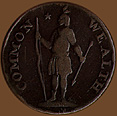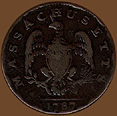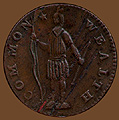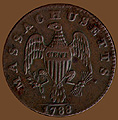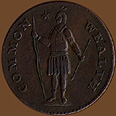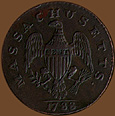Massachusetts Coppers 1787-1788
CENTS
obverse |
|
reverse |
| |||
1787 Ryder 2b-A MA horned eagle cent - Callender
Obverse: COMMON [star] WEALTH
Reverse: MASSACHUSETTS . 1787
Weight: 149.3 g (9.67 grams) Diameter: 29.2 mm Reverse die alignment: 180°
Comments: Created from a die by Joseph Callender. This is the second of two versions of the horned eagle variety. On the obverse of the first version of this die (die 2a) the tops of the letters and the bottom portion of the bow are very light. In the recut of that obverse, shown here, those areas are much more prominent. Also note, there is a small die break from the bottom serif in the first stroke of the N. The reverse die is easily recognized by the die break that extends from the top of the eagle's beak into the letter H above. Also note that in the bunch of arrows held by the eagle, the sixth arrow from the right is touching the tip of the wing feather.
Provenance: From the Robert H. Gore, Jr. Numismatic Collection.
obverse |
|
reverse |
| |||
1788 Ryder 3-E MA cent - Perkins
Obverse: COMMON [star] WEALTH
Reverse: MASSACHUSETTS . 1788
Weight: 152.4 g (9.87 grams) Diameter: 29.12 mm Reverse die alignment: 180°
Comments: Produced from a die by Jacob Perkins. The obverse can be distinguished as obverse 3 in that the top of the bow ascends to the top of the N in the legend and the ray of the star points towards the Indian's throat. Additionally, the butt of the arrow points towards the left of the E. There is also a diebreak at the letter N, which in this example goes to the rim. Obverse 3 was joined with reverses A and E. On this specimen there are several planchet striation marks across the front. The example was removed from an encased slab, where it had been assigned a PCGS grade of VF-35 (311.35/4775292).
The reverse can be distinguished as reverse E in that the lower left leaf of the olive branch touches the eagle's claw while opposite the third arrow from the right touches the eagle's wing tip. In all there are seven arrows in the eagle's talon with the fifth arrow from the right pointing to the bottom feather in the second row. The upper line above the date is heavy and in the date the central numerals 78 are lower than the outer numerals. In the legend the M and A are closer together than the A and S. Also, this is one of a few varieties where the final S ends above the point of the wing tip.This reverse was combined with obverses 3 and 11. This die shows the distinctive S with long serifs at either end, attributed to Perkins, giving it the appearance of being "closed" when compared with the less pronounced serifs on the "open" S in the dies attributed to Callender.
Provenance: Acquired through the the Robert H. Gore, Jr. Numismatic Endowment from the EAHA auction of January 17, 1998, lot 42.
obverse |
|
reverse |
| |||
1788 Ryder 10-L MA cent - Callender
Obverse: COMMON [star] WEALTH
Reverse: MASSACHUSETTS . 1788
Weight: 159.8 g (10.35 grams) Diameter: 29.1 mm Reverse die alignment: 180°
Comments: Produced from a die by Joseph Callender. On the obverse there are few easily distinguishing features. The arrow butt points to the upright of the E and the lower right ray of the star points towards the Indian's neck. On the reverse note that the date is spaced 17 88 and that the olive leaves are further from the wing than in other dies (ofter the top leaf touches the wing). Also the bundle of arrows contains some shafts without arrowheads. Note that on both sides of the coin the punch used for the letter C only has a thin serif at the top of the letter that only goes upward (more noticable in the scan of the obverse). This is a nice example of a common variety.
Provenance: From the Robert H. Gore, Jr. Numismatic Collection.
| Massachusetts Coppers p. 1 | Section Contents | Massachusetts Coppers p. 3 |
|
For viewing tips and information on optimal computer settings click
here.
For questions or comments contact Special Collections by: |
